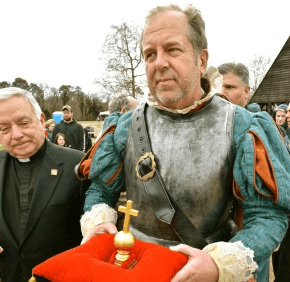
Archbishop William E. Lori blessed the Liberty Tree Cross March 18 at Fort McHenry National Monument. It was then placed on board the rebuilt 1812-era topsail schooner Pride of Baltimore II, where it was transported to Historic St. Mary’s City. (Maureen Cromer/CR Staff)
The Maryland Liberty Tree was a 600-year-old tulip poplar in Annapolis that served as a meeting spot for colonists seeking freedom during the American Revolution, and reportedly Washington and Lafayette met under the tree before marching to Yorktown. After the tree was destroyed by Hurricane Floyd in 1999, some of the roots were saved and later fashioned into three wooden crosses. The first two crosses were presented to Pope Francis and Prince Charles, and the third was brought to Historic St. Mary’s City for the tabernacle at the rebuilt Brick Chapel.


